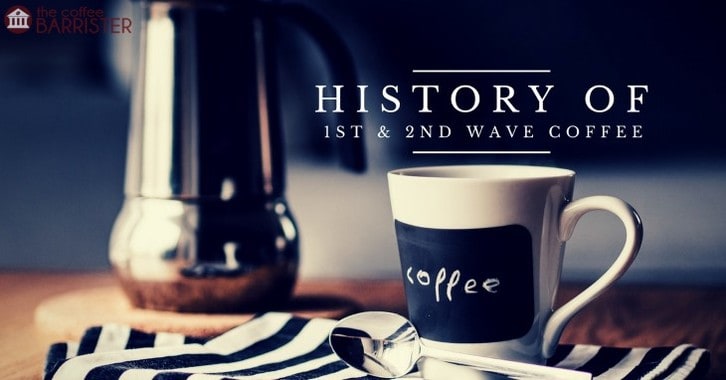
Similar to how we have splintered different groups of people into generations or how we categorize history by significant historical events, the how and why we consume coffee can be traced by significant historical disruptions or changes. We call these significant chunks of time “waves.” These waves are points in the history of consuming coffee where we drastically changed how we consume and produce coffee. Whether that was moving to vacuum-sealed canisters, or showing a fondness for growing origins, coffee too has had major changes over time.
To accurately look at the history of coffee, caffeinated historians have looked at how coffee developed over the world and what significant trends and changes happened to make coffee what it is today.
What is interesting about this analysis of coffee in historical waves is that most historians agree that there have only been three major and significant periods of diverse coffee growth. Even more interesting is that these waves have only been in recent history (the early 1900’s was the first big disruption in coffee production) even though we as a global community have been consuming coffee since at least the 15th century or earlier.
So what were the three major changes that happened to justify them as social game changers in the coffee consumption experience?
Let’s take a somewhat academic look at the history of coffee and look at some of the major changes and impacts it had culturally and globally in its three separate waves!
Today’s article will look at the origins, 1st and 2nd waves of coffee. Next week, we will look at the 3rd wave of coffee in full detail as it has had the most impact on our modern coffee consumption.
Origin of Coffee
Goat Herder & Sleepless Herds
This is more of a romantic story than it is the actual truth. In as early as the 10th century, a man by the name of Kaldi noticed his goats would exhibit an interesting almost overly energetic behavior after consuming a certain type of berry. The animals would run around for hours with no slowing down.
Kaldi gave the berries to a local monastery as a way to assist them in staying up late to continue their prayers and studies. The talk about these energizing berries quickly spread and these little fruits were popularized and in high demand in the Arabian Peninsula eventually having Cascara (coffee cherry) trees being grown in many countries in between the Arabian Peninsula.
The Coffee House
Although not considered an “official wave” of the coffee trend, it is important to note the first major disruption coffee had on its consumers. After the popularity of the coffee began to grow in the 15th and 16th centuries, coffee houses, known as “Qahveh KhaneN” in the middle east, became a popular space for people to come together to disseminate information and discuss politics, life, and the universe over an arousing and stimulating drink.
Coffee houses were so popular in fact that many historical figures used them as personal offices often receiving their mail and correspondence at them instead of their homes. Benjamin Franklin was an avid user of coffee houses and would visit any one of over 300 coffeehouses on a regular basis during his trips through Europe. In fact, Benjamin Franklin created the Franco-American Alliance of 1778 at the French café Procope.
To learn more about the impact of coffee houses, check out The History of the World in 6 Glasses!
1st Wave Coffee - Coffee Consumption
By the early 1800’s, coffee was a major staple in most modern countries. American’s became avid coffee drinkers after the Boston tea party of 1773 favoring coffee instead of tea as another stand against the British. Because of its mass consumption and popularity, coffee was on point to become one of the largest traded resources all over the world.
By this time, coffee was popular but not easily accessible. Because of taxation by volume as well as the inability at the time to preserve perishable items, coffee was not easily consumed in the home and had to be consumed at coffee houses or through local coffee roasters/vendors.
That changed when businesspeople wanted to find a way to make coffee both affordable and easily brewed in the home. This created two major changes in coffee growth and consumption.
Coffee Plantations All Over The World
The Best Part of Waking Up...
The other major development in the 1st wave of coffee was that of coffee becoming a staple of the modern person’s home. In the mid-18th century, companies like Maxwell House, Folgers and others started to create products to allow coffee to be easily consumed in the house.
The two major innovations that created this new market were vacuum sealed coffee containers (which are still used to this day in almost all coffee packaging) and dried instant coffee granules (again, another thing still used). These two products helped to remove the reliance of coffee consumption on local roasters and made coffee more easily accessible by placing it on retail shelves of grocery or convenience stores. The technological advances made by the vacuum sealer were able to help increase the shelf-life of coffee and get it to ship farther away from the roasting facility without sacrificing the quality of the coffee. This turned coffee from a drink meant for the upper class bourgeois to drink in their coffee houses into a staple for the modern simple working man. Socially, coffee became a drink of the masses.
To coincide with this movement of coffee away from the smart elite, major companies like Folgers, Maxwell House, and Mr. Coffee created marketing campaigns for their coffee products encouraging the average joe to make coffee become a staple in their daily routine as well as creating the 1st automatic home coffee drip makers. Although not really developed until the mid-1980’s, Folger’s iconic jingle “the best part of waking up” was a direct result of the 1st wave development and approach to how coffee was perceived and who drank it.
However, given our current perspective of coffee and quality, many historians critique the first wave of coffee for sacrificing quality and taste for ease of use and mass consumption. The pre-roasted and pre-ground coffee had a tendency to taste bitter and stale due to a lack of understanding and appreciation for coffee roasting and quality. This led to a long period of mediocre coffee and stale grounds on retail shelves.
2nd Wave Coffee - Where Everyone Knows Your Name
In the more recent years, in fact, closer to the end of the 19th century, coffee saw somewhat of a renaissance. Companies like Starbucks, Peets Coffee, and others wanted to bring back the community aspect of coffee and make it more of an enjoyable experience rather than a solitary ritual played out in the home to give you the energy to get you through the day.
The 2nd wave of coffee created a focus on enjoying coffee for its quality and experience. Howard Schultz, the owner of Starbucks, helped to create this new trend after having a life altering experience traveling to Europe and seeing how coffee shops function. With espresso based drinks and a sense of companionship and places of gathering, he decided to bring this type of old world lifestyle back to the U.S. His idea for coffee was to bring back the coffee house and dub them as “3rd Spaces” or the place people hang out in between work and home. That, along with the espresso based drinks which were relatively unknown in the United States, Schultz and others tried to create a new experience to experience, appreciate, and enjoy coffee.
The Cult of Starbucks & The 3rd Space
This new renaissance of coffee consumption also came from a more educated customer base who were done with mediocre or bitter tasting coffee. As coffee drinkers become more educated and wanted something that tasted better, coffee shops and roasters had to respond and act accordingly.
Coffee roasters especially started to experiment with different types of roasts and instead of using blends of coffees from all over the world, started to analyze, compare and contrast those coffees to look at the different flavor experiences you could create. Because coffee is grown all over the world in unique regions, coffee professionals started to notice that you could clearly taste major differences in those coffees. This was something that could be utilized to help appease the educated coffee consumers and create a full experience where they can really delve into the diversity that coffee can offer. For businesses, this was a consistent marketing and branding message to help them differentiate themselves and offer a “specialty coffee bean” experience that was a vast improvement over mediocre bitter coffee at home.
The 2nd Wave can be studied by watching shows like Friends or Frasier in the late 1990’s early 2000’s where people would regularly gather to sit around and talk about life. Similar to Coffee houses of the early 15th century, coffee once again became a social experience for people to partake in and enjoy other people’s company and specialty coffee and milk based drinks.
Companies like Starbucks really capitalized on this blend of old world coffee house gathering and new “specialty coffee bean” marketing and started to offer unique drinks that highlighted to the quality and diversity of flavors found in coffee. This included creating signature milk based drinks, offering a variety of roast styles, and highlighting and promoting individual coffee from different regions all over the world.
What Next?
As more and more people were starting to learn about coffee drinks like lattes, cappuccinos, and espressos, coffee producers started to see a new interest rise in coffee consumers. Quickly they were becoming accustomed to quality coffee drinks and producers knew they needed to act accordingly and create solid drinks. But at the same time, coffee consumers and producers were becoming more aware of the coffee chain and being aware of the uniqueness of coffee beyond the caffeine fix it provides.
To learn more about where coffee is and where it is heading don’t forget to read next week’s article on Wave 3!





